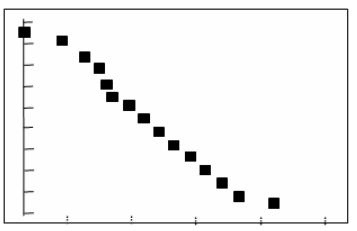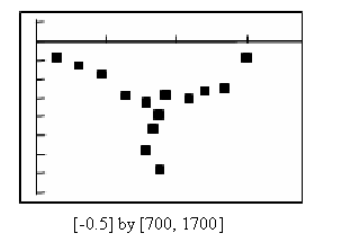
Concept explainers
(a)
To find: The sketch for the graph of the elevation ( y ) as the function of the distance downriver ( x ).
(a)
Answer to Problem 30E
The sketch of the graph is shown in Figure 1.
Explanation of Solution
Given Data:
The given table is shown in Table 1.
Table 1
| Distance down river in miles | River Elevation Feet |
| 0.00 | 1577 |
| 0.56 | 1512 |
| 0.92 | 1448 |
| 1.19 | 1384 |
| 1.30 | 1319 |
| 1.39 | 1255 |
| 1.57 | 1191 |
| 1.74 | 1126 |
| 1.98 | 1062 |
| 2.18 | 998 |
| 2.41 | 933 |
| 2.64 | 869 |
| 3.24 | 805 |
Calculation:
From the given table the graph of the data is shown in Figure 1.

Figure 1
In the above figure the x is the distance down the river and the y is the river elevation.
(b)
To find: The approximate graph of the given data.
(b)
Answer to Problem 30E
The required graph is shown in Figure 2.
Explanation of Solution
Consider the formula for the midpoint is,
The formula for the slope is,
Then, form the table 1 the table for the mid-point interval and the slope is shown in Table 2
Table 2
| Midpoint of the interval | Slope |
| 0.28 | -116.07 |
| 0.74 | -177.78 |
| 1.055 | -237.04 |
| 1.245 | -590.91 |
| 1.345 | -711.11 |
| 1.48 | -355.56 |
| 1.655 | -382.35 |
| 1.86 | -266.67 |
| 2.08 | -320.00 |
| 2.295 | -282.61 |
| 2.525 | -278.26 |
| 2.94 | -106.67 |
From the above data the approximate graph is shown in Figure 2

Figure 2
(c)
To find: The unit measure of the gradient.
(c)
Answer to Problem 30E
The unit of the gradient is in feet per mile.
Explanation of Solution
Consider the formula for the gradient is,
Since, the value of the elevation is feet and the distance down the river is in miles the unit of the gradient is in feet per mile.
(d)
To find: The unit measure that is appropriate for the derivative.
(d)
Answer to Problem 30E
The unit of derivative are feet per mile.
Explanation of Solution
The derivative is given by,
Here, y is the elevation that is in feet.
The distance is
The unit of derivative are feet per mile.
(e)
To find: The identification of the most dangerous section of the river by analysing the graph of part (a)
(e)
Answer to Problem 30E
The points where the change is the river elevation causes rapid increase in the speed of the river flow and this is the most dangerous section of the river.
Explanation of Solution
The steepest part of the curve and in this way the elevation drops rapidly and the most likely location for significant rapids. The points where the change is the river elevation causes rapid increase in the speed of the river flow and this is the most dangerous section of the river.
(f)
To find: The way in which the most dangerous section of the river is identified by the analysing the graph in ( b ) Explain.
(f)
Answer to Problem 30E
The lowest point is the point where there is signification change in depth and hence it is the most dangerous section of the river.
Explanation of Solution
The lowest point on the graph is the point where the elevation drops most rapidly and therefore the most likely location of the significant rapids.
Thus, the lowest point is the point where there is signification change in depth and hence it is the most dangerous section of the river.
Chapter 3 Solutions
Calculus 2012 Student Edition (by Finney/Demana/Waits/Kennedy)
Additional Math Textbook Solutions
A First Course in Probability (10th Edition)
Intro Stats, Books a la Carte Edition (5th Edition)
College Algebra with Modeling & Visualization (5th Edition)
Elementary Statistics (13th Edition)
Calculus for Business, Economics, Life Sciences, and Social Sciences (14th Edition)
- 3. FCX14) = x²+3xx-y3 +.arrow_forwardA cylindrical chemical storage tank with a capacity of 950m3 is going to be constructed in a warehouse that is 11m by 14m with a height of 10m. The specifications call for the case to be made of sheet metal that costs $90/m2, the top to be made from sheet metal that costs $45/m2 and the wall to be made of sheet metal that costs $80/m2. If you want to minimize the cost to make the storage house, how much would you end up spending to build the tank?arrow_forwardCalculate the max value of the directional derivatearrow_forward
- Calculus III May I please have the example, definition semicolons, and all blanks completed and solved? Thank you so much,arrow_forwardA company estimates that the revenue (in dollars) from the sale of x doghouses is given by R(x) = 12,000 In (0.02x+1). Use the differential to approximate the change in revenue from the sale of one more doghouse if 80 doghouses have already been sold. The revenue will increase by $ if one more doghouse is made. (Round to the nearest cent as needed.)arrow_forwardThe population of bacteria (in millions) in a certain culture x hours after an experimental 20x nutrient is introduced into the culture is P(x) = - 2 Use the differential to approximate the changes in population for the following changes in x. 8+x a. 1 to 1.5 b. 3 to 3.25 a. Use the differential to approximate the change in population for x=1 to 1.5. Between 1 and 1.5 hours, the population of bacteria changes by million. (Round to three decimal places as needed.)arrow_forward
- The demand for grass seed (in thousands of pounds) at price p dollars is given by the following function. D(p) 3p³-2p² + 1460 Use the differential to approximate the changes in demand for the following changes in p. a. $4 to $4.11 b. $6 to $6.19arrow_forwardLet the region R be the area enclosed by the function f(x) = 3 ln (x) and g(x) = 3 x + 1. Write an integral in terms of x and also an integral in terms of y that would represent the area of the region R. If necessary, round limit values to the nearest thousandth. Answer Attempt 1 out of 2 y 7 10 6 5 4 3 2 -1 2 3 4 5 6 x2 dx x1 = x2 = x1 Y1 = Y2 = Y1 dyarrow_forwardA manufacturer of handcrafted wine racks has determined that the cost to produce x units per month is given by C = 0.3x² + 7,000. How fast is the cost per month changing when production is changing at the rate of 14 units per month and the production level is 80 units? Costs are increasing at the rate of $ (Round to the nearest dollar as needed.) per month at this production level.arrow_forward
- dy Assume x and y are functions of t. Evaluate for 2xy -3x+2y³ = - 72, with the conditions dt dx dt = -8, x=2, y = -3. dy dt (Type an exact answer in simplified form.)arrow_forwardConsider the sequence below: 1 1 1 (a) Express this sequence as a recurrence relation (b) Express this sequence in the form {a}=1 (c) Does this sequence converge or diverge? Justify your answer. Consider the sequence below: 1 1 1 1, 4' 9' 16' (a) Express this sequence in the form {ak}=1 (b) Does this sequence converge or diverge? Justify your answer. Consider the sequence below: 345 2. 4' 9' 16' ·} (a) Express this sequence in the form {a}1 (b) Does this sequence converge or diverge? Justify your answer.arrow_forwardUse the growth rate of sequences theorem to find the limit or state it divergesarrow_forward
 Calculus: Early TranscendentalsCalculusISBN:9781285741550Author:James StewartPublisher:Cengage Learning
Calculus: Early TranscendentalsCalculusISBN:9781285741550Author:James StewartPublisher:Cengage Learning Thomas' Calculus (14th Edition)CalculusISBN:9780134438986Author:Joel R. Hass, Christopher E. Heil, Maurice D. WeirPublisher:PEARSON
Thomas' Calculus (14th Edition)CalculusISBN:9780134438986Author:Joel R. Hass, Christopher E. Heil, Maurice D. WeirPublisher:PEARSON Calculus: Early Transcendentals (3rd Edition)CalculusISBN:9780134763644Author:William L. Briggs, Lyle Cochran, Bernard Gillett, Eric SchulzPublisher:PEARSON
Calculus: Early Transcendentals (3rd Edition)CalculusISBN:9780134763644Author:William L. Briggs, Lyle Cochran, Bernard Gillett, Eric SchulzPublisher:PEARSON Calculus: Early TranscendentalsCalculusISBN:9781319050740Author:Jon Rogawski, Colin Adams, Robert FranzosaPublisher:W. H. Freeman
Calculus: Early TranscendentalsCalculusISBN:9781319050740Author:Jon Rogawski, Colin Adams, Robert FranzosaPublisher:W. H. Freeman
 Calculus: Early Transcendental FunctionsCalculusISBN:9781337552516Author:Ron Larson, Bruce H. EdwardsPublisher:Cengage Learning
Calculus: Early Transcendental FunctionsCalculusISBN:9781337552516Author:Ron Larson, Bruce H. EdwardsPublisher:Cengage Learning





